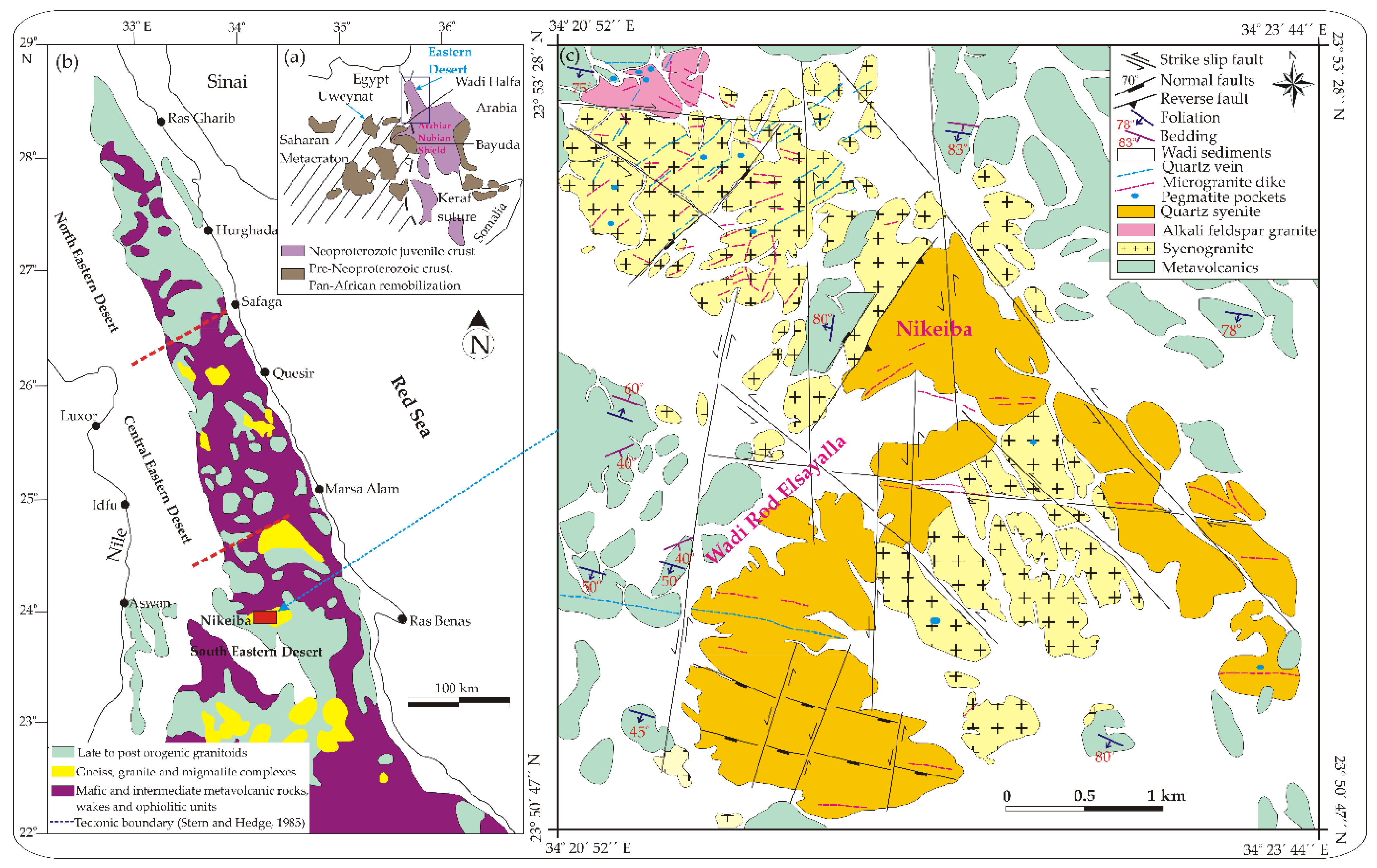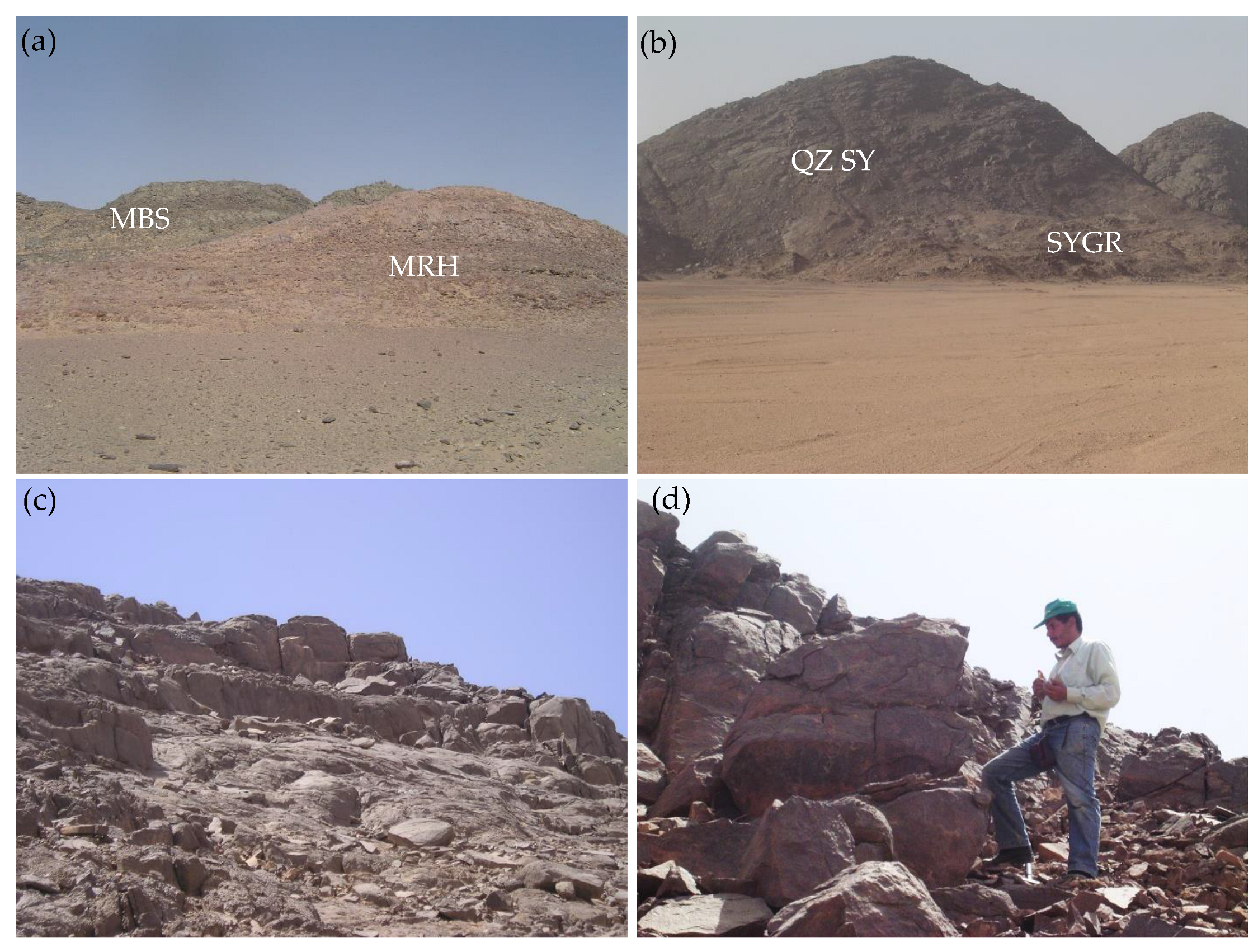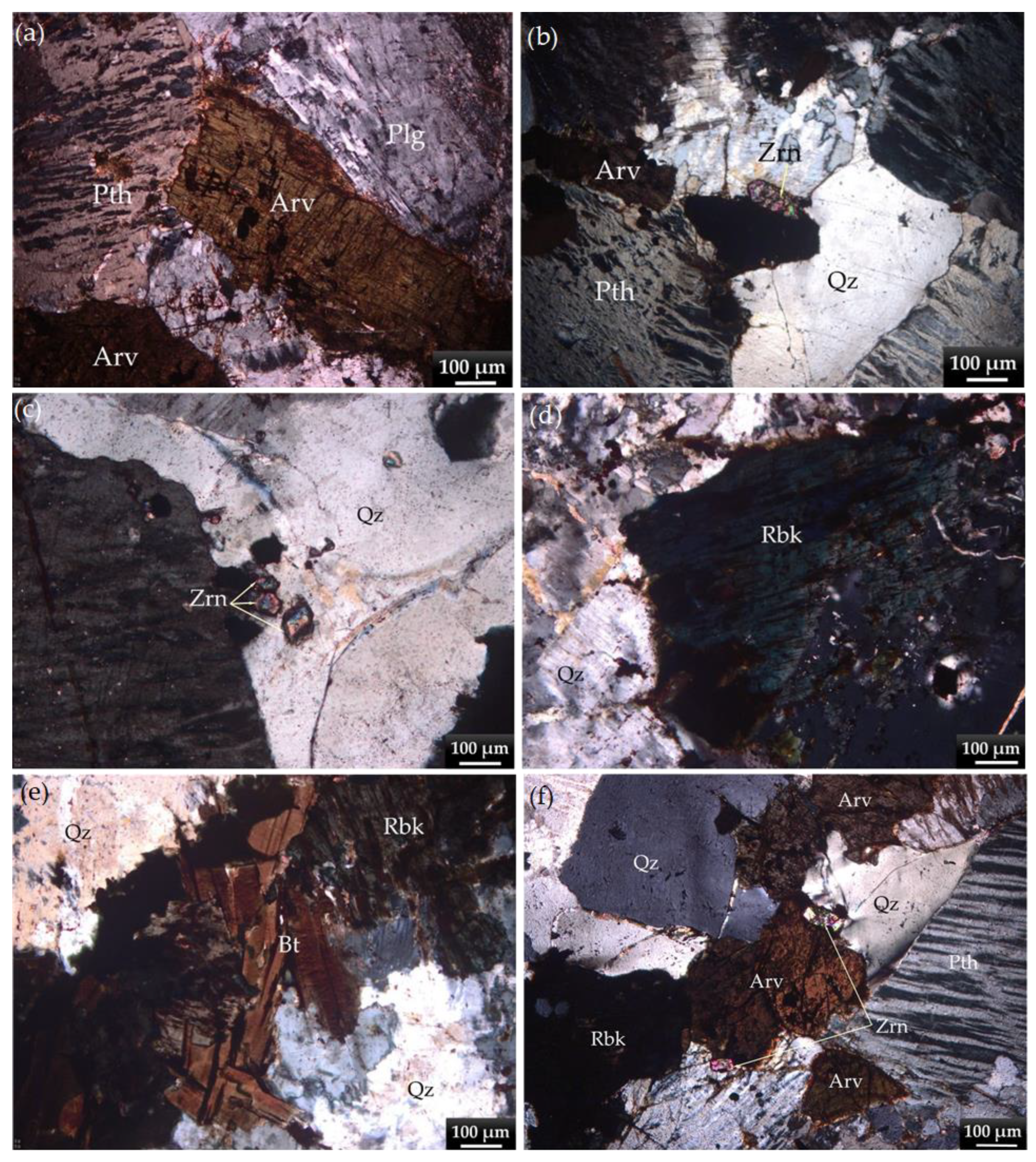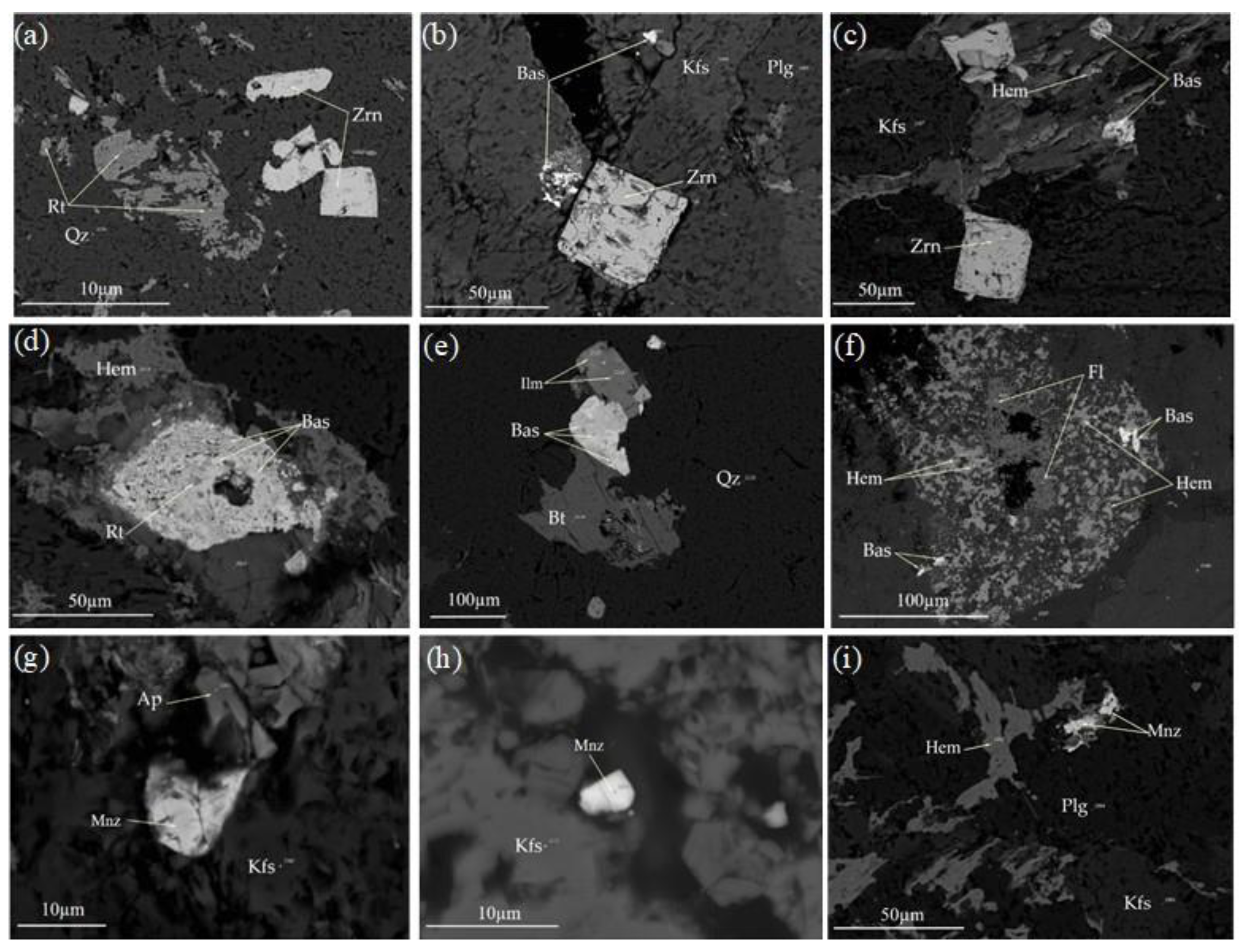5.1.2. Nb–Ta-Rich Minerals
Alkaline syenite is enriched in Nb–Ta-rich rare metals mineralization. They include columbite, microlite, and fergusonite.
Columbite occurs as massive, euhedral to anhedral crystals, elongated crystals, which are highly corroded and fine-grained (
Figure 4c–f). It occurs as fine microinclusions in ilmenite, and is always enclosed in K-feldspar, quartz, plagioclase, and biotite crystals. It is always associated with thorite, bastnäsite, microlite, zircon, ilmenite, hematite, and rutile. Some columbite crystals enclose fergusonite and hematite (
Figure 4f). The analyzed EPMA data reveal that columbite is composed of Nb
2O
5, which ranges from 66.49 to 71.57 wt%, Fe
2O
3 from 21.08 to 26.32 wt%, Ta
2O
5 from 2.55 to 3.69 wt%, and TiO
2 from 1.33 to 2.84 wt%. Y
2O
3 and MnO are recorded as minor constituents and reached up 3.62 and 1.08 wt%, respectively (
Table 2). EPMA show that Fe has a higher concentration than Mn (
Table 2), and indicates its typical composition of ferro-columbite according to [
42]. The ratio of Ta/(Ta + Nb) ranges from 0.02 and 0.03, whereas the ratio of Mn/(Mn + Fe) ranges from 0.02 to 0.05, indicating a marked enrichment of Fe compared to Mn in ferro-columbite crystals (
Table 2). The concentrations of radioactive elements uranium and thorium reveal that UO
2 and ThO
2 reached up 0.98 and 1.5 wt% in the analyzed ferro-columbite crystals.
Microlite presents as fine- to coarse-grained, reaching to 50 μm in size, is anhedral to subhedral, and has rhombic crystals, while others are corroded and highly deformed (
Figure 4c,g,h). It could be associated with ferro-columbite and thorite. Some crystals poikilitically enclose fine-grained hematite and opaques (gray to black grains). It is well-developed in quartz, plagioclase, and K-feldspar. EPMA shows that microlite is composed of Ta
2O
5, which ranges from 40.46 to 43.21 wt%, and Nb
2O
5 from 29.33 to 32.86 wt% and FeO, CaO, and TiO
2 reached up to 5.29, 4.84, and 1.13 wt%, respectively. Light rare earth elements LRE
2O
3 (La
2O
3–Nd
2O
3) are well recorded and range from 8.47 to 12.68 wt% (
Table 3). Microlite is enriched in radioactive elements, especially uranium in which UO
2 varies between 4.47 and 8.61 wt% (
Table 3).
Fergusonite occurs as fine-grained (
Figure 4f,i), subhedral to euhedral, tabular forms, which are highly corroded and well deformed. It is poikilitically enclosed in columbite crystals as fine-grained (white to pale gray grains). It is characterized by its submetallic or vitreous appearance. EPMA shows that fergusonite is composed of Nb
2O
5 and Y
2O
3 with averages of 48 wt% and 28.45 wt%, respectively. The total ∑TREE
2O
3 (Ce
2O
3–Yb
2O
3) of fergusonite from quartz syenite contains considerably higher concentrations, with an average of 15.91 wt%. Substantial amounts of TiO
2, CaO, Fe
2O
3, SiO
2, as well as ThO
2 and UO
2, are well reported (
Table 4). It has a structural formula of A
3+B
5+O4, where the A-site is dominated by REE and Y, and the B-site is occupied by Nb, Ta, and Ti. Other cations are recorded in the A-site.
5.1.4. REE-Minerals
From the investigated alkaline syenite, two groups of REE-minerals have been recognized: (i) fluorocarbonates and fluoride-REEs (bastnäsite and fluorite); (ii) phosphatic-REEs (monazite and apatite), (
Figure 4 and
Figure 5 and
Tables S1 and S2).
- i.
Fluorocarbonates and fluoride-REEs
Bastnäsite is the most predominant fluorocarbonate-LREE mineral recorded in the investigated alkaline syenite. It occurs as anhedral, tabular crystals, fine- to medium-grained, and reaches up to 50 µm (
Figure 4b,d and
Figure 5b–f). The EPMA data show that Ce
2O
3 has a higher concentration in the analyzed bastnäsite crystals, which ranges from 37.13 to 38.56 wt% with an average of 37.92 wt%, followed by La
2O
3, then Nd
2O
3, Pr
2O
3, and Sm
2O
3, with averages 20.43, 11.64, 3.10, and 1.79 wt%, respectively. The radioactive element thorium is reported in the analyzed bastnäsite crystals, and ThO
2 ranges from 0.58 to 2.21 wt%, with an average of 1.03 wt%. Y
2O
3, CaO, and Fe
2O
3 are recorded as minor constituents with averages of 1.18, 1.1, and 1.5 wt%, respectively. Consequently, Ce is considered the most predominant LREE (0.49 apfu) (
Table S1), and specifies bastnäsite-(Ce).
Fluorite (CaF
2) occurs as anhedral crystals and is mostly predominant in association with bastnäsite, monazite, and zircon crystals (
Figure 5f). It is enclosed in quartz, plagioclase, and K-feldspar crystals. EPMA data reveal that fluorite is composed of F 48.11 wt% and Ca 45.76 wt%. LREEs including La, Ce, Nd, as well as Y, are well presented as minor constituents reaching 1.39, 2.78, 1.46, and 2.21wt%, respectively. Its composition shows similarity to those fluorites recorded in the El Sela granite [
43].
- ii.
Phosphatic-REEs
Monazite presents as subhedral to anhedral crystals, fine-grained, and predominant in K-feldspar, plagioclase, and quartz (
Figure 5g–i). It is accompanied with apatite, zircon, thorite, and columbite. The EPMA data reveal that monazite is composed of P
2O
5, which ranges from 28.92 wt%, with especially enriched LREE concentrations ranging from 62.2 to 65.32 wt% (
Table S2). Ce
2O
3 shows a higher concentration other than LREEs in analyzed monazite crystals and ranges from 27.15 to 31.65 wt%. It is followed by Nd₂O₃, La₂O₃, Pr₂O₃, and Sm₂O₃, with average contents of 13.74, 12.08, 3.07, and 2.83 wt%, respectively. Gd
2O
3 is the only recorded HREEs in the analyzed monazite crystals with an average of 2.27 wt%. Radioactive elements, including thorium and uranium, are present, with ThO₂ and UO₂ reaching 2.72 wt% and 0.52 wt%, respectively. SiO
2 is present as a minor component, with an average of 1.21 wt%.
It is very clear to mention herein from the calculated chemical formula that monazite has a predominance of Ce (0.41 apfu) over other REEs, designating it monazite-Ce (
Table S2). The geochemical analyses of monazite crystals show a marked similarity in its composition with lower concentrations of thorium. This could be attributed to the geochemical substitutions that have been carried out according to the following reactions:
as recorded by [
12,
44].
Apatite occurs as anhedral to subhedral, massive, fine-grained, and enclosed in K-feldspar, quartz, and plagioclase (
Figure 5g). Apatite is predominately associated with monazite and zircon. The analyzed EPMA data reveal that CaO ranges from 53.21 to 54.61 wt%, and P
2O
5 ranges from 40.15 to 41.27 wt%. Apatite bears minor concentrations of LREE, especially La
2O
3, Ce
2O
3, and Nd
2O
3, and reached up to 1.05, 2.56, and 0.81 wt%, respectively. Fluorine ranges from 4.62 to 5.81 wt%, designating it fluorapatite.
5.1.5. Radionuclides Concentrations and Hazards
The concentrations of radionuclides
238U,
232Th, and
40K in alkaline syenite were determined, and the statistical analysis is summarized in
Table 6. Each element’s concentration was based on 50 samples (
n = 50), and the results offer insights into the variability, distribution patterns, and potential geological influences on these radionuclides. The mean concentration of
238U in the alkaline syenite was 108 ± 20 Bq/kg, reflecting moderate variability. The concentration ranged from 73 to 170 Bq/kg, indicating a relatively broad distribution. The positive skewness value of 0.55 suggests a moderate skew towards higher concentrations, while the kurtosis of 0.30 indicates a distribution slightly flatter than normal. The coefficient of variation (CV) was 0.19%, indicating that the concentration values are not significantly dispersed relative to the mean. These findings imply that
238U concentrations in syenite samples demonstrate variability but tend to cluster around the mean. Conversely, thorium (
232Th) concentrations exhibited relative consistency, with a mean of 107 ± 9 Bq/kg. The concentration range (89 to 121 Bq/kg) exhibited a narrower variation compared to that of 238 U, suggesting a reduced dispersion in the data. The skewness value of 0.14 suggests that the distribution is nearly symmetrical, while the negative kurtosis value of −1.16 points to a platykurtic distribution, indicating lighter tails compared to a normal distribution. The low coefficient of variation (CV) of 0.09% further corroborates the stability and low relative variability of
232Th in the samples. These findings suggest that
232Th is more uniformly distributed in the alkaline syenite samples. The mean concentration of
40K was found to be significantly higher than that of the other radionuclides, with a mean value of 1255 ± 166 Bq/kg. The concentration exhibited a considerable range, from 783 to 1628 Bq/kg, reflecting the natural abundance of potassium in rocks. The skewness value of −0.16 indicates a slight negative skewness, suggesting a distribution that is marginally skewed towards lower concentrations. The kurtosis value of 0.76 indicates a leptokurtic distribution, with a more pronounced peak than that of a normal distribution. The CV was 0.13%, indicating moderate variability relative to the mean. The mean concentration values of
238U,
232Th, and
40K in alkaline syenite samples were found to be higher than the worldwide average of 33, 45, and 412 Bq/kg, respectively [
3,
45]. These statistical patterns likely reflect the mineralogical and geochemical processes responsible for the distribution of radionuclides in the alkaline syenite. The elevated concentration of potassium relative to uranium and thorium is anticipated, given potassium’s role as a predominant constituent in numerous rock-forming minerals, including orthoclase and microcline, along with potassium-rich micas such as biotite and muscovite. In contrast, uranium and thorium are typically present in trace amounts. The relatively moderate variability in
238U and
232Th suggests that these radionuclides are uniformly distributed in the syenite rock matrix, with some localized enrichment in uranium-bearing minerals. In alkaline syenite, uranium is predominantly present in the microlite phase, while thorium manifests in the thorite and monazite phases. As demonstrated in the relevant literature, uranium is predominantly present in the microlite form within alkaline syenite. Conversely, thorium manifests in the thorite and monazite forms.
As indicated by the results of the Kolmogorov–Smirnov test (
Table 7), the concentrations of
238U,
232Th, and
40K in alkaline syenite samples appear to be normally distributed. This finding is consistent with the descriptive statistics, which revealed that the skewness and kurtosis values were within the acceptable range, suggesting that the data did not significantly deviate from normality. For
238U, the KS statistic of 0.08 and
p-value of 1.00 indicate a strong fit to normality, consistent with the descriptive statistics showing moderate skewness and kurtosis. A similar observation can be made with
232Th and
40K, which exhibited KS statistics of 0.12 and 0.09, respectively, with
p-values of 0.49 and 0.85. These results, too, support the hypothesis of a normal distribution, despite minor deviations in skewness and kurtosis. These findings serve to validate the underlying assumption of normality.
Table S3 discloses the radiological hazard parameters in the alkaline syenite samples and presents critical insights into the levels of natural radioactivity within the study area. The mean radium equivalent activity Ra
eq of 357 Bq/kg is slightly below the worldwide average of 370 Bq/kg [
46]. This finding indicates that, on average, the alkaline syenite rock in this region does not demonstrate excessively high levels of radioactivity compared to global standards. Nevertheless, the proximity to the mean value underscores the necessity for continuous monitoring, as variations in geological formations can result in localized increases in radioactivity that may not be reflected in mean measurements. Consequently, continuous assessments are imperative to elucidate the potential environmental and health impacts associated with natural radiation exposure. Notwithstanding the mean Ra
eq being within a safe range, the air-absorbed dose rate (D
air) of 166 nGy/h is considerably higher than the global average of 59 nGy/h [
47,
48]. This elevated dose rate indicates that individuals residing in or proximate to the alkaline syenite rock may experience heightened exposure to radiation relative to generally accepted safety limits. Such elevated levels of D
air can contribute to an increased risk of radiation-related health concerns, underscoring the necessity of community awareness initiatives and regulatory measures to mitigate exposure. Furthermore, the annual effective doses calculated for both outdoor (AED
out) at 0.20 mSv/y and indoor (AED
in) at 0.81 mSv/y indicate that outdoor and indoor exposure exceeds the global average of 0.07 and 0.41 mSv/y, respectively. Indoor environments are frequently where individuals spend the majority of their time, thereby increasing their cumulative exposure to radiation. Furthermore, the excess lifetime cancer risk (ELCR) average of 0.00071 indicates a relatively higher risk associated with prolonged exposure to these radionuclides compared to the permissible limit of 0.00029. This is of particular concern, as indoor environments are often where people spend the majority of their time [
49,
50]. While this risk is relatively low in absolute terms, it is crucial to consider the long-term exposure implications for populations residing in areas with heightened radioactivity. The observed maximum values for Ra
eq (437 Bq/kg), D
air (202 nGy/h), and AED
out (0.25 mSv/y) suggest that certain locations may pose significant radiological hazards, necessitating targeted investigations and protective measures. The findings underscore the necessity of regular monitoring and risk assessment to safeguard public health and ensure that exposure to radiation from natural sources remains within acceptable limits.
As illustrated in
Table S4, the Pearson correlation analysis discloses substantial relationships between radionuclide concentrations and radiological parameters in alkaline syenite samples. The analysis demonstrates a modest positive correlation of 0.15 between
238U and
232Th, suggesting a marginal tendency for their concentrations to increase in tandem. Conversely, the correlation between
238U and
40K is −0.01, indicating the absence of a substantial relationship between these two radionuclides. Furthermore,
232Th and
40K exhibit a modest positive correlation of 0.16, suggesting a negligible interdependence.
238U demonstrates a strong positive correlation with radium equivalent activity Ra
eq at 0.75 and air-absorbed dose rate D
air at 0.73, indicating its substantial contribution to overall radioactivity and radiation exposure. A similar correlation was observed between
232Th and Ra
eq (0.61) and D
air (0.58), suggesting its influence on radiation levels. In addition,
40K demonstrates moderate correlations with Ra
eq (0.49) and D
air (0.55), suggesting its influence on radiological exposure, though to a lesser extent than that observed for
238U and
232Th. The analysis also highlights strong correlations among radiological parameters themselves, such as D
air, AED, and ELCR, reinforcing the idea that higher radionuclide concentrations contribute to increased radiation exposure and associated cancer risks.
The cluster analysis (
Figure S1a) reveals distinct groupings among the radionuclides and radiological risk parameters based on their similarity. Notably,
40K forms a discrete group, indicating its unique behavior due to its significantly higher concentration compared to
238U and
232Th. Conversely,
232Th and ELCR exhibit a close proximity, thereby implying that thorium concentrations bear a significant correlation with cancer risk estimates. Radiological dose-related parameters such as AED (indoor and outdoor), D
air, and Ra
eq are grouped, reflecting their interrelationship in radiation exposure assessment.
238U is grouped with Ra
eq, emphasizing its contribution to radium equivalent activity and radiation exposure. The principal component analysis (PCA) (
Figure S1b) corroborates these findings by demonstrating that two primary factors account for the majority (88.46%) of the variance. The most significant variable along Factor 1 is
40K, followed by
232Th and
238U, indicating the predominance of potassium in terms of radiological influence. The close proximity of AED, D
air, and Ra
eq in the clustering analysis suggests a strong correlation between them. ELCR, on the other hand, exhibits a more independent behavior from the radionuclides, positioned along Factor 2. The integration of cluster analysis and PCA elucidates that
40K exerts a pronounced influence on radiological variance, while the remaining variables exhibit more pronounced interrelationships in terms of exposure and risk.
The statistical analysis (
Figure S1) indicates that
40K is the primary contributor to the observed radiological variance in the studied alkaline syenite samples. In contrast to
238U and
232Th, which are predominantly found in accessory minerals such as thorite, monazite, and zircon,
40K is a significant component of rock-forming minerals like feldspars and micas. Consequently, its concentration is considerably higher and more homogeneously distributed in the rock matrix. Although
40K exhibits a lower radiotoxicity compared to uranium and thorium, it contributes significantly to the external gamma dose due to its relatively high energy gamma emissions (1460 keV). This underscores the need to consider its role in radiological risk assessments of alkaline syenite and similar rock types. While
40K does not pose significant internal exposure risks unless ingested or inhaled in substantial amounts, its contribution to ambient gamma radiation should not be overlooked, particularly in indoor environments where prolonged exposure may increase cumulative dose rates. In light of the statistical findings, future radiological assessments of building materials derived from alkaline syenite should evaluate
40K contributions alongside uranium- and thorium-related hazards to provide a more comprehensive risk assessment.













